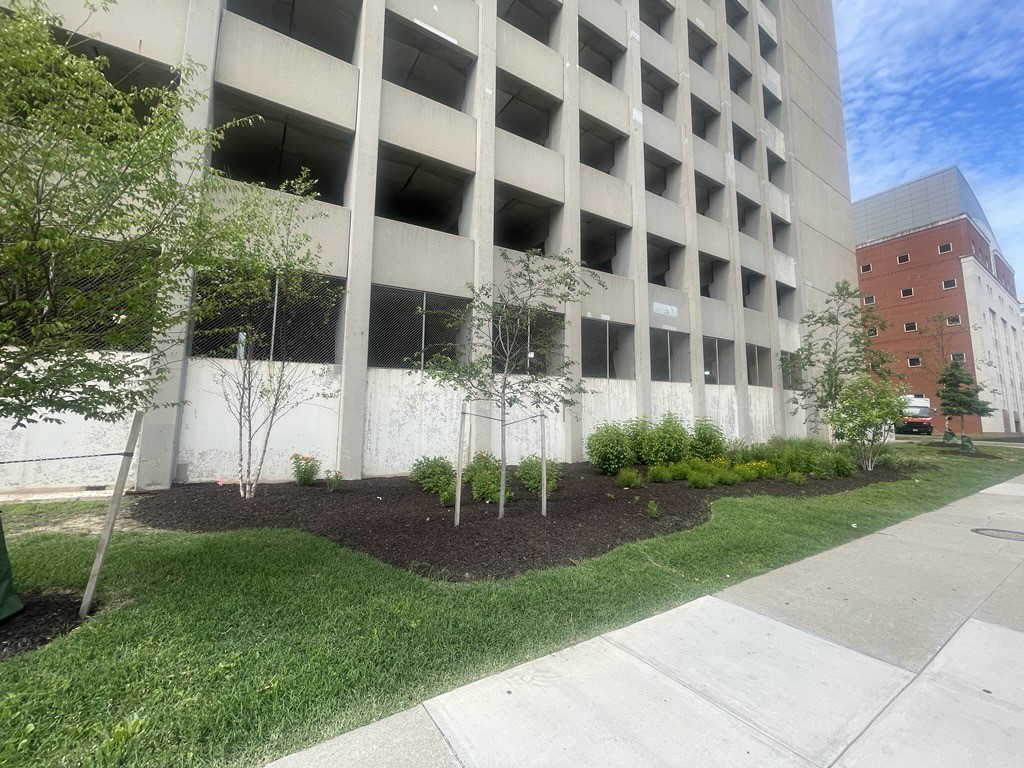The Benefits of Biochar at UMB
May 21, 2025 Angela Ober
The use of biochar is just one of the many environmentally friendly landscaping practices on campus.
In the summer of 2024, UMB began applying biochar into new planting areas. UMB’s landscape contractor, BrightView, used 3,350 pounds of Mimimichi Green CarbonizPN-G granular soil enhancer at 25 locations on campus last year. This product is a blend of biochar and compost that is added to the soil. It helps retain moisture, reduce compaction, promote deeper root growth, and more. The University will continue to apply this soil amendment to newly planted areas each year.
Here are some commonly asked questions about biochar:
Most people are familiar with how compost is made and its benefits, so what is biochar and what are its environmental benefits?
Biochar is created by taking organic material and burning it in a high-heat, low-oxygen environment, also known as pyrolysis. The feed material varies from wood chips to plant residues to poultry waste and other agricultural waste.
Creating biochar sounds like creating charcoal — what’s the difference?
Biochar is produced at a much higher temperature and can be made from any type of biomass. It’s also much more porous than traditional charcoal and is used specifically for landscaping and agriculture whereas charcoal is used for heating.
Traditional fertilizer has been an environmental concern due to its excessive use, leading to runoff of nutrients into the waterways. This nutrient-rich runoff can degrade water quality, increase algal blooms, and cause losses in biodiversity for the local ecosystem. Biochar is a fertilizer alternative that also has carbon sequestration capabilities. It is especially helpful in repairing nutrient-deficient soils found in urban areas.
According to the World Economic Forum, “On average, biochar application significantly increases plant productivity by 16%, crop yield by 13%, water use efficiency by 20%, soil organic carbon by 39% and available soil nutrients by +45% for phosphorus. Furthermore, biochar can reduce emissions of nitrogen oxides by -11% and plant heavy metal uptake by -29%.”
Where can you find sites that used biochar on campus?
One great example is on the south side of the Pratt Street Garage, where native plants and a clover-meadow mix (in lieu of traditional grass lawn) were installed. Other areas include: outside of the Pine Street Station and Annex, the Pharmacy Hall long bed, the School of Nursing landscaped beds, the SMC Campus Center, Health Sciences and Human Services Library, and more.
Sean Ryan of BrightView talks about the benefits these types of amendments have on the soil: "With consistent and proper application, Mirimichi Green's carbon-based soil amendments can transform even the most compacted soils into thriving, biologically active environments —enhancing root development, improving water and nutrient retention, and fostering long-term soil health for sustainable plant growth." This is especially noticeable on the south side of Pratt Street Garage, where poor conditions and compaction had been an issue.
The applications for biochar are growing outside of landscaping use. New innovations have even combined biochar into construction materials like cement and insulation as a way to remove carbon from our atmosphere.
BrightView continues to think of new ways to implement sustainable practices into the University’s landscaping. In addition to applying biochar to sites on campus, BrightView also responsibly disposes of its landscaping debris by mulching or composting it at its facility after visiting a site.